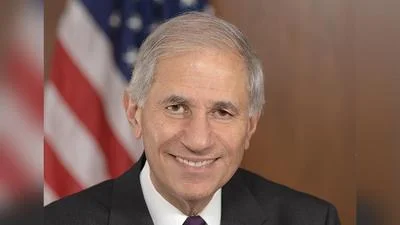The practice of yoga encourages slow and deep breathing through your nose. | Wikimedia Commons/Surya Namaskar
The practice of yoga encourages slow and deep breathing through your nose. | Wikimedia Commons/Surya Namaskar
Anxious people understand how inhaling deeply through the nose helps reduce stress; this happens because of calming nerve receptors that send calming hormones to the brain.
Nasal breathing is also very effective in fitness endeavors, such as yoga.
“I so love people who have yoga backgrounds going into endurance sports,” George Dallam, a professor in the School of Health Sciences and Human Movement at Colorado State University-Pueblo, told U.S. News and World Report. “That’s a useful thing. The single biggest issue we have for aerobic exercise in this country is people go out and go at it too hard, and it’s horrendous for them.”
As many people know, having allergies or sinus inflammation is an uncomfortable feeling. Imagine falling asleep, but you can’t breathe through your nose.
“Mouth breathing is not good,” Dr. Anthony Sanders of Indianapolis Sinus Center told East Indy News. “It can affect sleep quality. For instance, you're probably more likely to have sleep apnea, which is a major problem in its own right.”
Chronic sinusitis is inflammation in the nasal cavity that lasts for more than three months. It can cause congestion, runny nose, pain in the ears, headaches and even tooth pain, to name a few symptoms.
“There have been studies that have shown people with chronic sinusitis are much more prone to depression than the general population without rhinosinusitis,” Sanders said. “This may be just the fact that it's such a quality-of-life issue. People have a lot of symptoms, which tends to compromise their ability to concentrate, to sleep well.”
A recent study published in the International Journal of Kinesiology and Sports Science studied 10 runners, male and female, who implemented nasal-only breathing for six months while exercising. Their maximum rate of oxygen consumption did not change from nasal to mouth breathing. But the study found that the runners’ respiratory rate, which is breaths per minute, and ratio of oxygen intake to carbon dioxide output, decreased during nasal breathing.
In other words, their bodies didn’t have to work as hard to get the same amount of oxygen. Researchers believe this is because of the lower breath rate used during nasal breathing, which allows more time for oxygen to get to the bloodstream. This study suggests that you can produce the same work and oxygenation while breathing through your nose as you can with your mouth. When you breathe slowly and deeply through your nose like you do in yoga, you extract more oxygen from each breath, which allows you to breathe less.
Breathing through the nose while exercising promotes good form, good posture, and even prevents injuries. When breathing slowly through the nose, people allow their lungs to fill up and use the diaphragm more efficiently.
The way to get used to breathing through the nose while exercising is to push yourself until you feel the sensation of what researchers call “air hunger,” or breathlessness, and only challenge yourself as much as you can while maintaining nasal breathing. This means slowing down significantly at first and being patient. This process can take anywhere from six weeks to six months, depending on your fitness level and how committed you are.
If you're interested in evaluating your sinus symptoms and are considering seeing a doctor, take this Sinus Self-Assessment Quiz.




 Alerts Sign-up
Alerts Sign-up